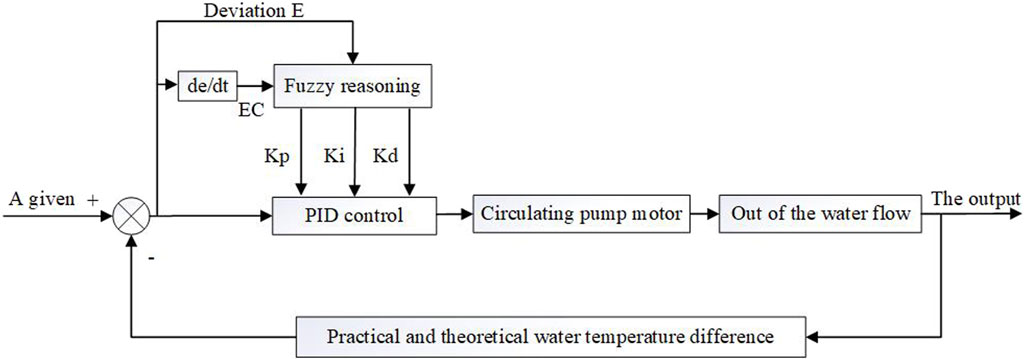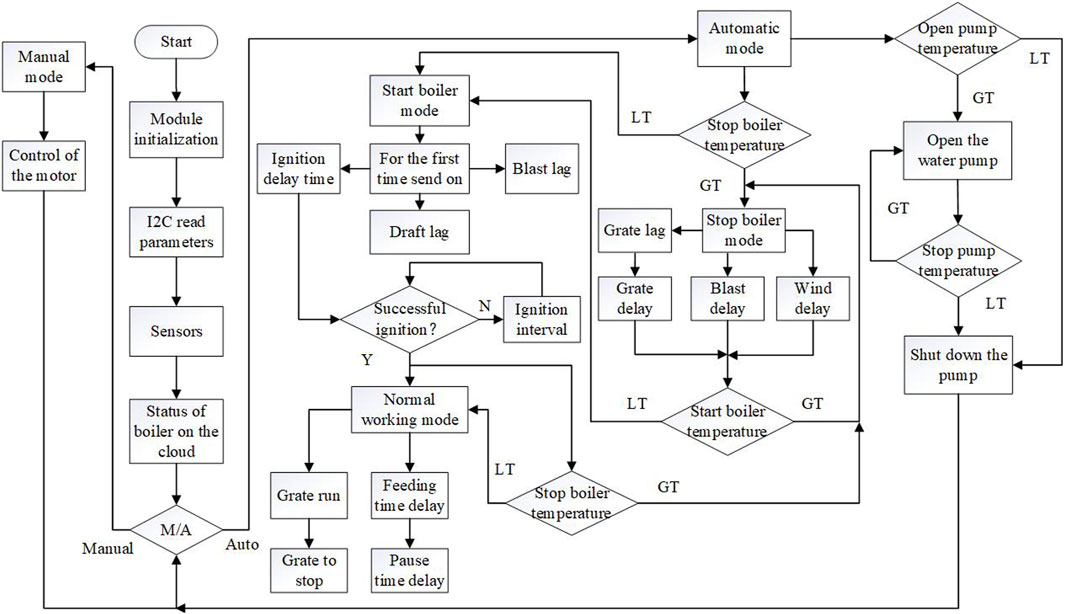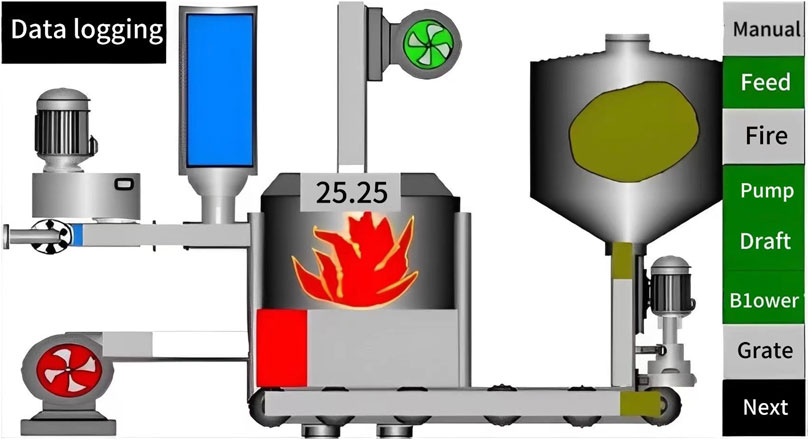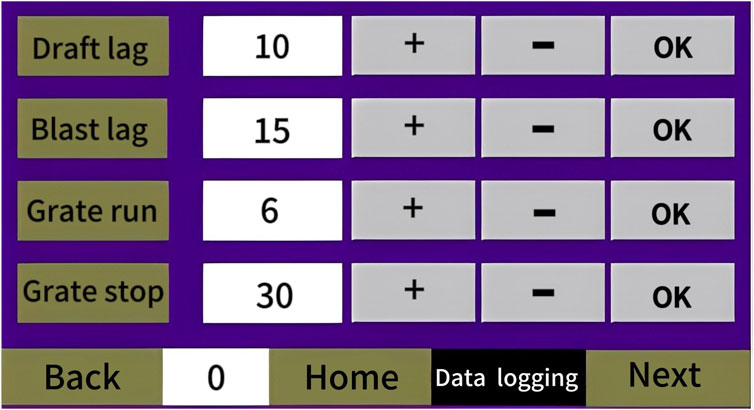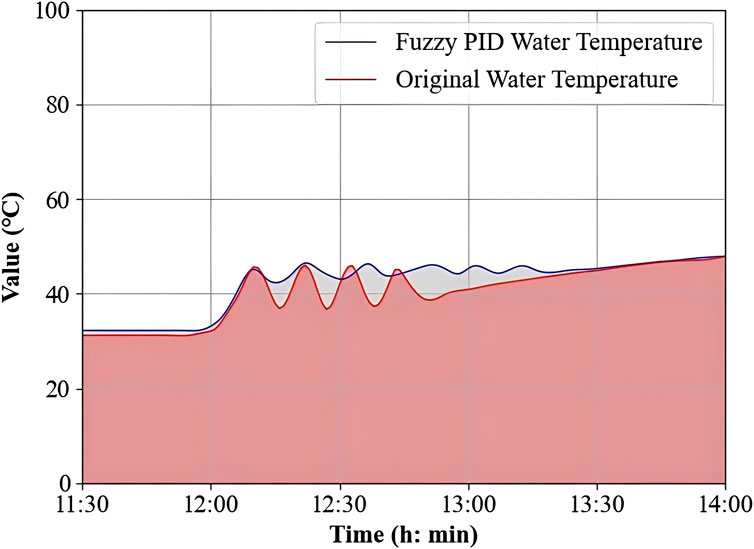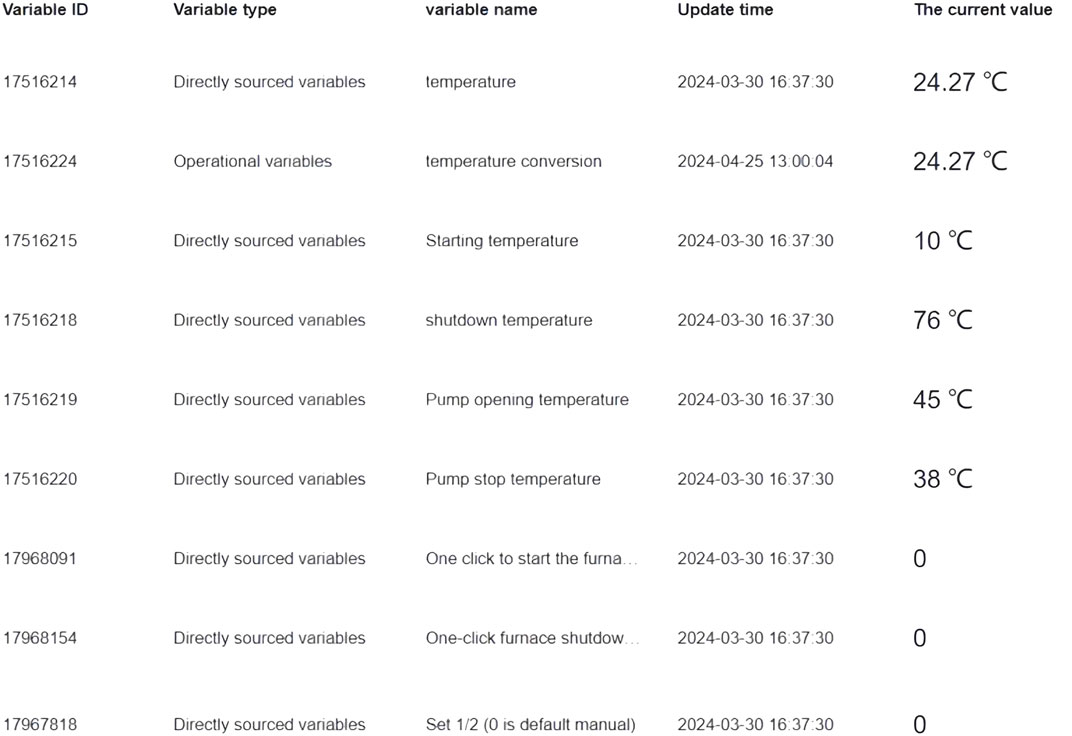- 1Key Laboratory of Smart Breeding (Co‑Construction by Ministry and Province), Ministry of Agriculture and Rural Affairs (TJAU), Tianjin, China
- 2College of Engineering and Technology, Tianjin Agricultural University, Tianjin, China
- 3College of Humanities, Tianjin Agricultural University, Tianjin, China
Traditional biomass boiler operations predominantly rely on manual control, with adjustments made based on operator experience. This approach not only demands considerable manpower but also leads to suboptimal resource utilization. Addressing the specific operational dynamics of biomass boilers, this study introduces a controller designed around the STM32 microcontroller. This device employs a modular architecture and incorporates cost-effective chips and peripheral components. To enhance energy efficiency and the overall user experience, the controller utilizes pulse width modulation pulse modulation alongside a fuzzy PID control strategy. Capable of toggling between manual and automatic modes for local operations, it also supports data logging directly on the device or in the cloud. Tailored to meet diverse user requirements, the controller facilitates remote monitoring and management. It employs a strategic control mechanism for various motors, ensuring precise hot water temperature measurements within the boiler and enabling data uploads to cloud platforms. This not only conserves energy and reduces labor costs but also promotes environmental sustainability and operational efficiency. Through ongoing refinement and rigorous testing, the controller has achieved a level of maturity that underscores its readiness for widespread implementation.
1 Introduction
Biomass energy is known as the fourth generation energy that can replace non-renewable energy sources such as coal, oil and natural gas. The carbon emitted during its combustion process is only part of the carbon absorbed during its growth, basically achieving zero carbon emissions (Xiang et al., 2022). Biomass boilers utilize biomass materials such as wood, straw, and waste to convert into thermal energy for heating, hot water, and steam production, functioning as a greener alternative to traditional coal-fired boilers. These boilers are composed of a combustion chamber, boiler body, and a flue gas treatment system, leveraging renewable biomass resources to offer a solution with significantly reduced environmental impact and enhanced sustainability. Biomass boilers find application across various domains, including but not limited to industrial manufacturing, agricultural processing, and residential heating (Zhou et al., 2017; Liu et al., 2018; Šulc and Oswald, 2021).
Given the diversity in biomass fuel characteristics, usage demands, and environmental guidelines, the design and type of biomass boilers vary. Modern advancements equip some biomass boilers with sophisticated combustion control and flue gas treatment technologies, aimed at minimizing emissions and boosting energy efficiency (Przemysław et al., 2020; Cornette et al., 2021; Ciupek et al., 2024).
The realm of biomass boiler control encompasses a suite of operations and technological methods dedicated to the monitoring, adjustment, and regulation of operational parameters, ensuring the system’s safety, stability, and efficiency (Abrams and Toupin, 2007; Dedi et al., 2022). Traditional biomass boiler control systems may lack precise control of fuel supply, air volume, temperature and other parameters (Wang and Liu, 2010; Liu and Liu, 2018; Liu et al., 2024). This may lead to unstable combustion processes and affect the thermal efficiency and energy utilization of the boiler (Li et al., 2023). At the same time, the traditional biomass boiler control system may not be able to fully utilize the energy of biomass fuel. For example, unstable fuel supply or incomplete combustion process will convert most of the energy into the flue gas (Khamis and Lesewed, 2014). According to statistics, the exhaust heat loss of biomass boilers is the largest loss among all losses during the combustion process, exhaust heat loss accounts for 60%–70% of all losses (Pu et al., 2014; Zhao et al., 2019). Due to the lack of remote monitoring functions in traditional biomass boiler systems, operators may not be able to monitor equipment status in real time, which may result in delayed discovery of faults or inability to deal with problems in a timely manner, increasing boiler safety hazards and thus affecting equipment performance and safety (Zhao et al., 2018; Chou, 2023).
Today’s primary focus lies in the development and application of innovative methods for biomass control (Shao et al., 2022). Addressing the operational features of biomass boilers and user requirements, this paper introduces a cost-effective and smart biomass boiler controller (Chen and Zheng, 2019; He, 2020; He and Li, 2020; He, 2022). This innovation supports both automatic and manual control, marrying remote with local management to optimize energy utilization, decrease emissions, save on labor, and guarantee safe and consistent boiler operation (Feng, 2012; Liu, 2015; Li et al., 2017; Jana et al., 2021).
2 Methodology
For the central processing unit (CPU), the selection favored the STM32 microcontroller series, specifically the STM32F103RET6 model. This choice was aimed at ensuring that the hardware not only fulfills the performance demands of the controller but also remains economically viable. The design methodology embraced modularity, facilitating the independent assembly and replacement of various system components. This approach not only reduced costs by leveraging the economies of scale associated with standardized modules but also simplified manufacturing and maintenance processes. Lower-cost peripheral components, such as relays, wireless data transmission modules, and sensors, were selected to meet the requisite control functionalities without significantly inflating costs. Circuit designs were intentionally simplified to eliminate unnecessary complexity and features, focusing solely on the indispensable functions critical for the boiler’s control mechanism. This strategy effectively minimized the quantity and cost of the necessary components.
Traditionally, parameter settings in biomass boiler controllers have been predominantly based on the operators’ experiential judgment, reflecting a relatively rudimentary level of automation. This project introduced a fuzzy PID algorithm, utilizing pulse width modulation (PWM) for regulating the operational cycles of the circulation pump according to predefined control protocols between the set temperature for pump activation and the actual temperature of the hot water. This mechanism aims to maintain the output water temperature aligned with the boiler’s hot water temperature, thereby gradually elevating the piping system’s temperature to safeguard the infrastructure and augment the heating comfort for end-users. Automatically adjust the flow rate of the circulation pump according to changes in temperature to achieve the function of a climate compensation system, which not only ensures the stability and efficiency of the supply system, but also reduces energy consumption and maintenance costs.
Furthermore, the controller was designed with a data storage feature, allowing operators to easily access and manage the biomass boiler controller, including the monitoring of historical parameters and statuses. To enhance operational efficiency and reduce labor costs, remote monitoring and control capabilities were incorporated via a wireless transmission module. Using the STM32 microcontroller, operational data from the boiler are transmitted to a cloud-based platform for energy efficiency analysis. Leveraging learning algorithms and data analytics, the system provides optimization recommendations aimed at boosting the biomass boiler’s energy utilization efficiency.
3 System design
3.1 Biomass boiler controller hardware design
At the heart of this design lies the STM32F103RET6 microcontroller, which processes signals from temperature sensors (NTC/PTC) through its ADC peripheral for precise temperature readings. These readings enable the controller to manage outputs to various I/O ports automatically based on predefined temperature limits. Enhanced user interaction is achieved through serial communication for direct touch screen control and physical buttons for intuitive operation. The design incorporates an AT24C08 EEPROM via I2C communication for retaining user-configured settings, ensuring settings persist across reboots. Remote monitoring and control capabilities are provided by a DTU, allowing for the observation and management of boiler parameters and sensor data in real-time from mobile devices or cloud services.
3.1.1 Power circuit
Given the industrial setting, where voltages can exceed 220V, a stable power supply is critical. The controller’s touch screen operates at 5V, the STM32 at 3.3V, and the DTU at 12V. Voltage conversion circuits transform 220V AC to 12V, and subsequently to 5V and 3.3V through switching power supplies and linear regulators, providing stable power to all components and ensuring operational reliability.
3.1.2 Temperature sensing circuit
Temperature sensing, vital for controlling the biomass boiler’s load motors, requires precise conversion of sensor signals to digital formats for the microcontroller. Temperature sensors, both NTC (e.g., B3950, B3435, and B3470) and PTC (e.g., PT100, PT1000), output low-voltage signals that are amplified and conditioned for digital conversion, facilitating accurate temperature monitoring and control.
3.1.3 Relay control circuit
The boiler is managed through six control variables: motors for the grate, feed, blower, draft, circulation pump, and the igniter, necessitating varied power levels and operational voltages. Solid-state relays, driven by amplified signals from the STM32’s I/O ports and isolated by optocouplers, enable the electronic circuit to safely control these high-power components, minimizing electrical interference and ensuring smooth operation.
3.1.4 Interface and peripheral circuit
The controller is designed with user-friendly tactile buttons for essential functions, including power, mode switching, and direct control of the boiler’s operational variables. A bistable circuit controls power to the STM32 and touch screen, facilitating easy operation. Parameters are stored in an AT24C08 EEPROM, ensuring user settings are preserved without needing reconfiguration after power cycles.
3.1.5 Touch screen and remote transmission module
The user interface employs a Taojing series USART/HMI touch screen, chosen for its cost-effectiveness, low energy consumption, and high resolution. It displays critical boiler parameters and allows for easy adjustment of operational settings. The Yunren Cloud DTU module ensures data from the boiler can be transmitted for remote viewing and control, offering convenience and enabling efficient boiler management from anywhere.
3.2 Software system design for biomass boiler controller
3.2.1 Control strategy
The controller operates in both automatic and manual modes, allowing users to manage energy use effectively and perform direct control of operational variables as needed. It intelligently switches modes based on water temperature, engaging the heating system at optimal times to maximize energy efficiency and minimize unnecessary power usage.
3.2.2 Fuzzy adaptive PID algorithm
The controller utilizes a fuzzy PID algorithm that adapts to the system’s current state in Figure 1, adjusting control parameters in real-time for optimal performance. This approach allows for rapid initial adjustments and finer control as the system approaches its target state, ensuring efficient and precise temperature regulation.
3.2.3 Software design workflow
For programming the controller, KEIL5 software was used, employing C language to craft the control strategy for the biomass boiler. The program’s architecture is built on three primary structures: sequential, selection, and looping constructs, allowing for comprehensive and effective control over the boiler’s operations. The main procedural flow, depicted in Figure 2, systematically illustrates the controller’s operational logic. This methodology underpins a reliable execution of the biomass boiler’s control mechanisms, ensuring optimal performance and efficiency in managing the system’s variables.
4 Experimental results
4.1 Functionality and implementation of the serial touch screen interface
Figure 3 showcases the touch screen display interface of the biomass boiler controller, which is pivotal for monitoring, controlling, and managing the operational aspects of the system. The interface dynamically adjusts to display control buttons corresponding to different motor actions, allowing operators to promptly respond to system needs for effective maintenance and management. Figure 4 illustrates the parameter settings interface, exemplifying how users can configure and fine-tune various settings and options through the touch interface. This feature empowers operators to adjust biomass boiler operating parameters directly on the screen, enhancing user interaction. Furthermore, the interface is equipped with an operational data logging feature, which archives historical data for subsequent analysis and study. This capability is designed to improve both the efficiency and reliability of the system or device.
4.2 EqDisplay effects on the industrial internet platform (Youren Cloud)
The integration of a Data Transmission Unit (DTU) facilitates the transmission of biomass boiler parameters to a server, which subsequently uploads this data to the Youren Cloud platform for visualization. This platform not only displays the data but also allows for the remote control of the biomass boiler, enabling functionalities like one-click start and stop operations, as depicted in Figure 7. Figure 5 red curve showcases a temperature curve derived from the actual temperature changes in the boiler hot water during the combustion process. The process begins at a startup temperature of 31°C, with the pump activation set at 45°C and deactivation at 35°C. Throughout the normal combustion from 12:00 PM to 12:45 PM, the pump cycles on and off to circulate water heated to 45°C to the heating elements, forming a temperature waveform. In the last cycle of activation, the circulating water does not reach the shutdown temperature, leading to equalization of the temperatures in the boiler and the heating system. Due to a large heating surface area, the temperature of the hot water increases slowly until it reaches the shutdown threshold of the boiler, signaling the end of operation until the next activation cycle. Figure 5 blue curve illustrates the application of fuzzy PID control in managing the start and stop cycles of the circulation pump, which stabilizes the temperature of the water leaving the boiler to match that of the boiler’s hot water. Following the initial pump activation, the variance in the boiler’s hot water temperature decreases and stabilizes. When the first pump point temperature is reached, PID control stabilizes the boiler outlet water temperature at the preset pump start temperature. The variance of the subsequent curves with PID control is 1.7, while without PID control, the variance is 11.8, which is significantly larger. Thus, the fuzzy PID control has a notable effect on stabilizing the water temperature. Figure 6 shows the impact of different control methods on the circulating pump on indoor temperature. Comparing the red curve and the blue curve, it can be clearly seen that the method of using fuzzy PID combined with temperature fuzzy control and PWM is better than the traditional method of pump-open temperature and pump-stop temperature control method provides more precise control, allowing the biomass boiler to utilize fuel energy more effectively, which has a positive impact on the heating system. At the same time, it can cope with various changes and uncertain factors during the operation of the biomass boiler, improving the stability and robustness of the system. These graphical representations provide a clear analysis of the biomass boiler’s combustion process, performance evaluation, and enhancement of resource utilization efficiency.
5 Conclusion
Utilizing advanced embedded and remote wireless communication technologies, the project has developed a biomass boiler controller capable of a wide range of functionalities, including both local and remote control, data archiving, and signal collection. This controller is designed with a focus on practical application, adhering to the operational principles of biomass boilers and addressing user requirements through intelligent, cost-effective research and development. It effectively employs a fuzzy PID control strategy to optimize system operations while enabling real-time performance monitoring, significantly improving energy efficiency. Extensive testing has led to the creation of reliable electronic circuitry and software programming for the controller, successfully implementing the features desired by users. From a cost-saving perspective, this approach has proven beneficial in reducing labor, time, and resource expenditures, suggesting a promising future and high utility for the controller in practical applications.
Data availability statement
The original contributions presented in the study are included in the article/Supplementary Material, further inquiries can be directed to the corresponding author.
Author contributions
CY: Investigation, Methodology, Project administration, Software, Supervision, Validation, Writing–original draft, Writing–review and editing, Conceptualization, Data curation, Formal Analysis. WX: Writing–review and editing, Writing–original draft. YJ: Data curation, Formal Analysis, Funding acquisition, Investigation, Project administration, Resources, Supervision, Visualization, Writing–review and editing, Methodology. ZM: Formal Analysis, Methodology, Supervision, Writing–review and editing. ZC: Writing–review and editing. HW: Writing–review and editing. SL: Data curation, Writing–review and editing.
Funding
The author(s) declare that financial support was received for the research, authorship, and/or publication of this article. Research and development of intelligent distributed clean and efficient straw Boiler, Heilongjiang Province launched the project, the project funds 10 million yuan, contract No. 2023ZXJ02C04. Intelligent Energy management System for biomass molding fuel boiler, Key Research and Development Program of Heilongjiang Province, the project funds 3.6 million yuan, contract No. GA21C026.
Acknowledgments
The authors wish to extend their gratitude to Harbin Hadong Xinchun Boiler Co., Ltd. for providing a venue for conducting their experiment. They also thank Tianjin Agricultural University for its invaluable technical support during the research process.
Conflict of interest
The authors declare that the research was conducted in the absence of any commercial or financial relationships that could be construed as a potential conflict of interest.
Publisher’s note
All claims expressed in this article are solely those of the authors and do not necessarily represent those of their affiliated organizations, or those of the publisher, the editors and the reviewers. Any product that may be evaluated in this article, or claim that may be made by its manufacturer, is not guaranteed or endorsed by the publisher.
References
Abrams, F. R., and Toupin, K. (2007). Efficient and low emission stoker-fired biomass boiler technology in today's marketplace. Power Eng. Mag. Power Generation 111 (6), 90–92.
Chen, W., and Zheng, L. (2019). Research on intelligent IoT terminal design for industrial boiler remote monitoring based on embedded technology. Ind. Heat. 48 (06), 34–37. doi:10.3969/j.issn.1002-1639.2019.06.011
Chou, Y. (2023). Application of automation technology in boiler heating system and heating energy saving. Papermak. Equip. Mater. 52 (11), 49–51. doi:10.3969/j.issn.1672-3066.2023.11.017
Ciupek, B., Urbaniak, R., Kinalska, D., and Nadolny, Z. (2024). Flue gas recirculation system for biomass heating boilers—research and technical applications for reductions in nitrogen oxides (NO x) emissions. Energies 17 (1), 259. doi:10.3390/en17010259
Cornette, J. F. P., Thibault, C., Hélène, L., Blondeau, J., and Bram, S. (2021). Particulate matter emission reduction in small- and medium-scale biomass boilers equipped with flue gas condensers: field measurements. Biomass Bioenergy 148, 106056. doi:10.1016/j.biombioe.2021.106056
Dedi, S., Paber, S., and Cahyo, R. Y. (2022). Energy efficiency and energy saving potential analysis of biomass boiler at the PT greenfields Indonesia milk processing plant. IOP Conf. Ser. Earth Environ. Sci. 1034 (1), 012012. doi:10.1088/1755-1315/1034/1/012012
Feng, Z. (2012). Design of an intelligent electric heating boiler controller. Non-State Run. Sci. Technol. Enterp. 05, 82.
He, J. (2020). Design of a water heating boiler controller based on single-chip microcomputer. ISSN 20 (06), 166. 1671-1939.
He, J. (2022). Design and development of a biomass hot air furnace controller based on single-chip microcomputer. Industrial Technol. Vocat. Educ. 20 (06), 9–12. doi:10.16825/j.cnki.cn13-1400/tb.2022.06.024
He, J., and Li, J. (2020). Research and design of an electric boiler controller with remote control function. Industrial Technol. Vocat. Educ. 18 (01), 10–12. doi:10.3969/j.issn.1674-943X.2020.01.004
Jana, M., Ján, P., Alexander, H., Pavlenko, I., Ochowiak, M., and Khovanskyi, S. (2021). Biomass combustion control in small and medium-scale boilers based on low cost sensing the trend of carbon monoxide emissions. Processes 9 (11), 2030. doi:10.3390/pr9112030
Khamis, S. A., and Lesewed, A. A. (2014). Control of biomass boiler water temperature using adaptive control system. Planet. Sci. Res. Cent. 73, 6–8.
Li, D., Wang, Q., and Li, Y. (2017). Intelligent controller for small biomass boiler based on embedded system. J. Shenyang Inst. Eng. Nat. Sci. 13 (01), 15–19. doi:10.13888/j.cnki.jsie(ns).2017.01.004
Li, J., Xue, Y., Du, Y., Pan, Z., Zhang, J., Shao, Y., et al. (2023). Coordinated economic dispatch of the primary and secondary heating systems considering the boiler’s supplemental heating. Front. Energy Res. 10. doi:10.3389/fenrg.2022.1005784
Liu, M., and Liu, H. (2018). Design and implementation of a level control system for gas hot water boilers based on STM32. Meas. Control Technol. 37 (09), 159–162. doi:10.19708/j.ckjs.2018.09.037
Liu, T., Yin, Y., and Yin, H. (2018). Discussion on the optimization control of embedded energy-saving and environmental protection coal-fired boilers. Mod. Chem. Res. 02, 107–108. doi:10.3969/j.issn.1672-8114.2018.02.066
Liu, Y. (2015). Application of single-chip microcomputer technology in electric hot water boilers. Autom. Appl. 10, 62–63. doi:10.3969/j.issn.1674-778X.2015.10.027
Liu, Y., Meng, Y., and Chen, Z. (2024). Design and simulation of biomass boiler combustion control system using fuzzy PID control. Pract. Electron. 32 (01), 83–86. doi:10.3969/j.issn.1006-5059.2024.01.019
Przemysław, M., Danuta, K., Sławomir, P., and Juszczak, M. (2020). Numerical modelling and experimental verification of the low-emission biomass combustion process in a domestic boiler with flue gas flow around the combustion chamber. Energies 13 (21), 5837. doi:10.3390/en13215837
Pu, Y., Jiang, T., and Chen, Z. (2014). Statistical analysis reduces exhaust gas temperature and optimizes boiler operation. Energy Conserv. Technol. 32 (06), 571–574. doi:10.3969/j.issn.1002-6339.2014.06.023
Shao, Y., Liu, J., Huang, J., Hu, L., Guo, L., and Fang, Y. (2022). The implementation of fuzzy PSO-PID adaptive controller in pitch regulation for wind turbines suppressing multi-factor disturbances. Front. Energy Res. 9. doi:10.3389/fenrg.2021.828281
Šulc, B., and Oswald, C. (2021). Ecological aspects in control of small-scale biomass fired boilers. Int. J. Energy 15, 33–40. doi:10.46300/91010.2021.15.6
Wang, R., and Liu, G. (2010). Application of energy-saving control method for water circulation pumps in winter heating. Autom. Appl. 01, 27–28+32.
Xiang, T., Zhou, L., and Zheng, B. (2022). Energy efficiency analysis of biomass molded fuel boilers and research on energy saving and emission reduction technologies. China Spec. Equip. Saf. 38 (4), 82–86. doi:10.3969/j.issn.1673-257X.2022.04.017
Zhao, H., Qiu, Z., and Xiong, W. (2018). Technical analysis of remote online monitoring system for industrial boilers. Energy Conserv. Technol. 36 (01), 22–25. doi:10.3969/j.issn.1002-6339.2018.01.005
Zhao, Y., Wang, J., and Song, G. (2019). Research on utilization technology of latent heat potential of gas boiler flue gas. Energy Conserv. Technol. 37 (05), 408–412+446. doi:10.3969/j.issn.1002-6339.2019.05.006
Keywords: biomass boiler, single-chip microcomputer, intelligent, cost, energy efficiency
Citation: Ye C, Xu W, Jiang Y, Mu Z, Cui Z, Wu H and Liu S (2024) Design of the control and remote monitoring energy system based on an embedded biomass boiler. Front. Energy Res. 12:1434112. doi: 10.3389/fenrg.2024.1434112
Received: 17 May 2024; Accepted: 03 July 2024;
Published: 26 July 2024.
Edited by:
Wenke Zhao, Harbin Institute of Technology, ChinaReviewed by:
Haibo Zhou, Tianjin University of Technology, ChinaMin Addy, University of Minnesota Twin Cities, United States
Copyright © 2024 Ye, Xu, Jiang, Mu, Cui, Wu and Liu. This is an open-access article distributed under the terms of the Creative Commons Attribution License (CC BY). The use, distribution or reproduction in other forums is permitted, provided the original author(s) and the copyright owner(s) are credited and that the original publication in this journal is cited, in accordance with accepted academic practice. No use, distribution or reproduction is permitted which does not comply with these terms.
*Correspondence: Yongcheng Jiang, amlhbmd5b25nY2hlbmdAdGphdS5lZHUuY24=
 Cheng Ye
Cheng Ye Wei Xu1,3
Wei Xu1,3 Yongcheng Jiang
Yongcheng Jiang